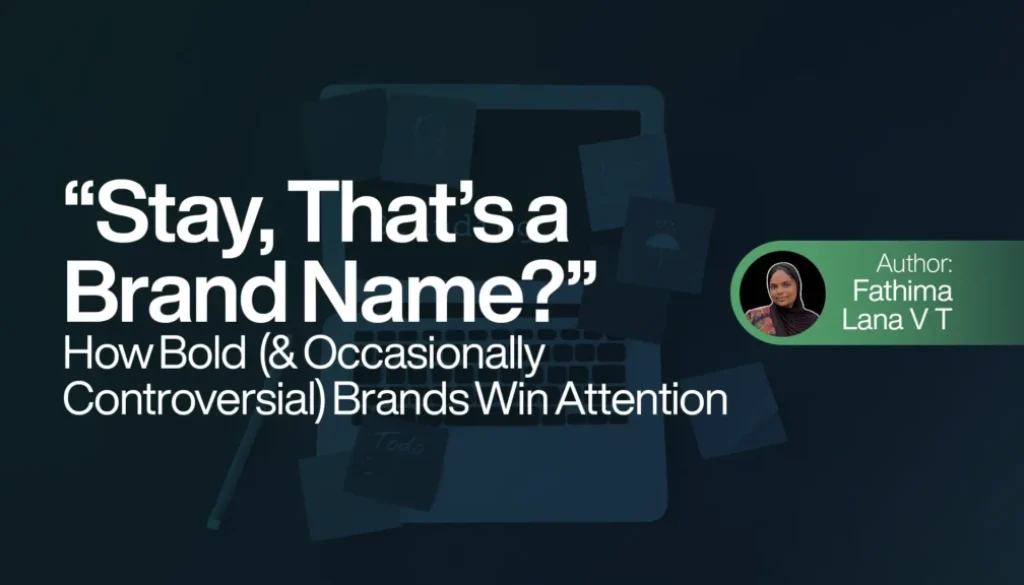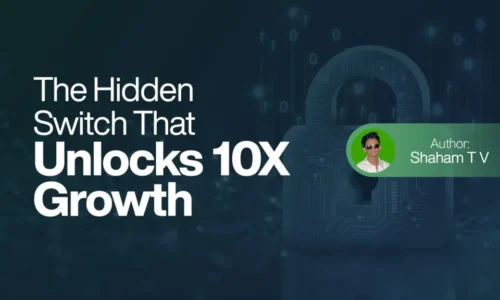“Stay, That’s a Brand Name?” – How Bold (and Occasionally Controversial) Brands Win Attention
I remember sitting in a park back in 2022, reading a book and doing my business, almost. A conversation between two college students at the next table caught my attention. One of them casually said, “I just bought Nothing.” The other replied, puzzled, “You bought what?” That pause, that little moment of confusion, lodged itself in my brain. Because Nothing isn’t a vague statement it’s an actual tech brand.
Table of Content
Why Bold Names Work (Even If They Confuse You at First)
The Psychology of Disruption
Emotions and intellectual responses are triggered using bold brand names. When that response is unexpected like confusion, amusement, or even mild offense it creates a moment of mental dissonance. In psychology, this is called the “contrast effect.” It’s why a brand like Death Wish Coffee sounds more memorable than Premium Brewed Coffee.
The brain thrives on patterns, but it remembers the exceptions.
Disruptive names create micro-moments of curiosity, and that curiosity leads to discussion, sharing, and ultimately conversion. You don’t need millions in ad spend if your name is doing half the work for you.
From Garage Dreams to Headline Memes: Real Stories of Bold Branding
Let’s look at brands that have successfully used bold (sometimes risky) names to cut through the noise and how you can apply their thinking.
1. Nothing (UK) – A Minimal Name Making Maximum Noise
Founded by Carl Pei (of OnePlus fame), Nothing is a tech startup with a mission to blend design and technology in a seamless, transparent way. Their first product, the Nothing Ear (1), featured a clear casing that exposed the device’s internal components, a literal reflection of their brand values.
But more importantly, the name itself is an act of rebellion. In a world of “NeoTech,” “HyperX,” and “Realme,” the brand chose absence as its identity. And guess what? It worked.
Marketing takeaway: Contradiction breeds interest. Naming your brand something counterintuitive makes it memorable and newsworthy.
2. Elon Musk’s The Boring Company (USA)
What do you call a company that digs tunnels? Elon Musk called it Boring. It’s a pun yes but also a statement. It flips the idea of tech innovation on its head. By choosing the driest name possible for an ambitious infrastructure startup, Musk reminded us that branding isn’t about impressing everyone it’s about owning your narrative.
The irony made it viral. The company even sold flamethrowers (yes, really) and got press simply because of the absurdity.
Marketing takeaway: Humor works. It humanizes your brand and makes technical products feel approachable. Don’t underestimate the power of irony.
3. Ugly Drinks (UK) – Brutally Honest Bubbles
Ugly Drinks is a sparkling water brand that challenges the artificial beauty standards of sugary soft drinks. By calling themselves Ugly, they’re embracing realness both in ingredients and in identity.
The brand’s positioning says: “We’re not pretending to be perfect, and neither should you.” In a culture of over-filtered everything, that’s refreshing.
Marketing takeaway: Embrace imperfection. Modern customers often resonate more with honesty and authenticity.
4.Liquid Death (USA)
What sounds like a metal band is actually a canned water company. They sells mountain water in tallboy beer cans. Their tagline? “Murder your thirst.”
Their entire branding strategy is a rebellion against the “yoga chic” wellness industry. Instead of pastel colors and flower petals, they go all-in on skulls, black cans, and aggressive copywriting.
And it’s working. They’ve raised millions in funding, built a cult following, and turned water into a lifestyle.
Marketing takeaway: When everyone else zigs, zag. Drastic contrast from category norms gets attention fast.
5. Glossier (USA) – Soft Power in a Loud World
Glossier shows that boldness doesn’t have to shout. The name is soft, elegant, and airy much like the subtle, dewy finish of the products it offers. Unlike traditional beauty brands that scream glamour (Revlon, L’Oréal, Fenty), Glossier invites you in gently.
And that subtlety is its boldness. It was one of the first DTC brands to use minimalism and relatability as selling points in an industry built on perfectionism.
Marketing takeaway: Bold doesn’t always mean loud. Sometimes, it means choosing silence in a room filled with noise.
What Makes a Bold Name Work?
So how do you actually craft a name that gets noticed? Here are some key principles bold brands use:
1. Tension or Contradiction
Names like Nothing and Liquid Death are built on contradiction. They create cognitive dissonance that sparks curiosity. You want people to say: “Wait… what?”
2. Humor or Irony
Irony is incredibly shareable. Think The Boring Company or Ugly Drinks. They make people smile, which increases recall and shareability.
3. Extreme Simplicity
Boldness can also come from being radically simple. A name like Glossier or Oatly is short, distinctive, and easily pronounced across languages.
4. Cultural Rebellion
Stand out by going against what’s expected. Whether it’s disrupting luxury (Brandless) or masculinity (Harry’s razors), cultural commentary makes a name more meaningful.
5. Ownable Language
Great names often create their own vocabulary. Think of Googling, Tweeting, or Netflix and chill. These brand names became verbs. Some become memes and hashtags.
Naming for Personal Brands: Yes, You Can Be Bold Too
This isn’t just for big corporations. If you’re building a personal brand as a freelancer, creator, or entrepreneur you can use the same principles.
It’s a unfair advantage to have a bold Instagram ID, Youtube channel name, and website domain. Here are some tips for individuals:
- Avoid generic terms: Don’t call your art page “Creative Vibes” when you could go with “Scribble Witch” or “Pixel Drama.”
- Inject personality: Your name should reflect your tone. Are you quirky, spiritual, punk, geeky? Say it with your title.
- Don’t fear controversy: As long as it’s aligned with your values and not offensive without cause, a polarizing name can work for you
When Bold Names Backfire (and What to Learn)
Of course, being bold can go wrong.
Pepsi’s “Bubly” sparkling water was cute, but confused people with Michael Bublé’s name until they made that part of their campaign.
- ISIS Chocolates, the belgium brand rebranded their name because of terrorist group gained notoriety.
- Boaty McBoatface, while hilarious, reminded us that viral doesn’t always equal credibility.
Lesson? Be bold, but be aware. Boldness should be intentional, not accidental.
Final Thoughts: Do You Dare to Be Remembered?
In a crowded digital world, safe choices often become invisible. A bold name won’t guarantee success, but it will guarantee one thing: attention.
And attention is where everything begins.
So whether you’re naming a company, a product, or your own Instagram account don’t aim to please everyone. Aim to stand out. If people pause, laugh, frown, or even squint at your name, good. That means it’s working.
The brands we remember most are the ones that made us feel something the moment we heard their name.
Maybe the question isn’t “Is this too bold?”
Maybe it’s: “Is this bold enough?”




